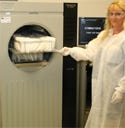Packaging & Sterilization
September 7, 2008
Originally Published MPMN September 2008
OUTSOURCING OUTLOOK
Packaging & Sterilization
|
Jody Birks, RA/QA manager, Eagle Medical Packaging and Sterilization Inc., Paso Robles, CA. |
Medical device manufacturers have many choices available to them when selecting a sterilization method. Key considerations include device material compatibility (functional and cosmetic), packaging type, validation and production costs, and turnaround time. It is important to realize that all sterilization technologies have limitations, and to know the specific drawbacks of each one, some of which follow below. There is no perfect solution, and no “one size fits all.”
The majority of devices are sterilized by one of three general methods: heat/steam, irradiation, or by application of a chemical sterilant. Steam exposes devices to high heat and humidity, which can compromise the product in some cases. Gamma irradiation can change the molecular structure of plastics and silicones in an undesirable manner. And E-beam sterilization has product-penetration limitations.
Chemical sterilants work by inactivating organisms; ethylene oxide (EtO), for example, sterilizes by alkylation. The sterilant substitutes for hydrogen atoms on molecules needed to sustain life, and, by attaching to these molecules, EtO stops their normal life-supporting functions. However, EtO has residual toxicity issues, is costly and complicated to validate, and requires a long cycle time.
Whatever the method, a good contract sterilization firm should be willing to supply a wealth of information about a given technology in order to help the OEM find the most compatible solution for a specific application.
High-Barrier Packaging Protects Devices Sensitive to UV Light
|
A firm’s high-barrier aluminum foil laminate pouches are used to package and protect diagnostic tests, microtiter plates, and other medical devices that are sensitive to UV light, moisture, and oxygen permeation. Standard packaging types include films in roll-and-bag format and zipper bags for microplates. Offering packaging and converting services, the company is ISO 9001:2000 registered, and also offers die-cutting, printing, narrow web slitting, and subassembly capabilities.
G & L Precision Die Cutting, San Jose, CA
www.glprecision.com
Firm Specializes in Custom Thermoform Packaging
|
Specializing in custom thermoform packaging for medical devices, a company operates a 200,000-sq-ft facility that includes Class 10,000 and Class 100,000 cleanrooms. The firm can thermoform a variety of standard materials, including PET, PVC, HIPS, and HDPE, as well as specialty multilayered materials that provide increased oxygen and moisture barriers in order to meet FDA packaging requirements. In-house testing equipment ensures consistency, cleanliness, accuracy, and functionality.
OraTech, Salt Lake City, UT
www.oratech.com
Packaging Heads Up Company’s Turnkey Offerings
|
A company provides packaging and sterilization of orthopedic, spinal, cardiovascular, and neurological devices. Certified to ISO 11607 standards for packaging of terminally sterilized medical devices, the firm also offers package integrity testing per ASTM 1929 guidelines, and package strength testing according to ASTM F88-06 seal/peeling testing guidelines. The company assists customers with various sterilization services, including designing protocols, performing sterility validations, conducting routine processing, and overseeing quarterly dose audits. A recent facility upgrade doubled the size of the company’s manufacturing headquarters to 54,000 sq ft. The plant contains three Class 10,000 cleanrooms.
Quality Tech Services Inc., Bloomington, MN
www.qtspackage.com
Organization Provides Contract Packaging Services in Class 100,000 Cleanroom
|
An organization specializes in packaging FDA-registered medical products in a Class 100,000 cleanroom. Available packaging types include instant hot packs, instant cold packs, and instant reusable cold packs; in addition, a durable tape underwrap can be incorporated specifically for sensitive medical devices. Contract manufacturing and assembly of Class II medical devices are also available. A primary mission of the organization is to provide employment opportunities to disabled citizens.
Employ+Ability, Braintree, MA
www.workisgood.org
Hydrogen Peroxide Sterilization Offers Fast Cycle Times
|
Benefits of gas plasma (vaporized hydrogen peroxide) sterilization are fast cycle times, the absence of toxic residuals, and a low-moisture environment not exceeding 50ºC, according to the only provider of this sterilization method on the West Coast. The company’s service boasts material compatibility with 95% of metal and nonmetal devices, including fiber-optic, electronic, and microsurgical products, as well as medical devices sensitive to heat and moisture. Operating a facility certified to ISO 13485:2001 standards, the firm also provides additional services such as packaging design, packaging seal-strength testing, packaging integrity testing, cleanroom assembly, ultrasonic cleaning, irradiation, and bar coding.
Eagle Medical Packaging and Sterilization Inc., Paso Robles, CA
www.eaglemed.com
Copyright ©2008 Medical Product Manufacturing News
You May Also Like








